If you are reading this blog post, definitely you want to learn Ukulele Tabs or tablature.
Right?
Maybe, you have come across ukulele tabs, which is a shorthand way to note down your music and that’s why you want to learn ukulele tabs.
But, the problem is, as a beginner you don’t know how to read them.
In this blog post, I will break down everything about reading ukulele tabs that you need to know in the process of learning ukulele.
This guide covers the basics of ukulele tabs to play your favorite songs by reading the tabs.
Related,
Disclosure: This post may contain affiliate links, which means we may receive a commission if you click a link and purchase something that we recommended. Read more about Affiliate disclosure here.
- Boys Don’t Cry Ukulele Tabs and Chords by The Cure
- I’m Yours Ukulele Chords and Tabs
- Stay With Me Ukulele Chords and Tabs
So, without further ado, let’s dive into this ultimate guide to ukulele tabs.
Contents
- What is Ukulele Tabs?
- The Basics of Ukulele Tabs
- Anatomy of Ukulele Tabs
- Ukulele Tabs Symbols
- How to Interpret and Play Chords in Ukulele Tabs
- How to Play Ukulele Tab Melodies
- Ukulele Tabs Reading Tips and Tricks
- Common Mistakes You Should Avoid When Reading Ukulele Tabs
- How to Use Online Ukulele Tabs Resources
- Ukulele Tabs Practice Exercises
- Bottomline
What is Ukulele Tabs?
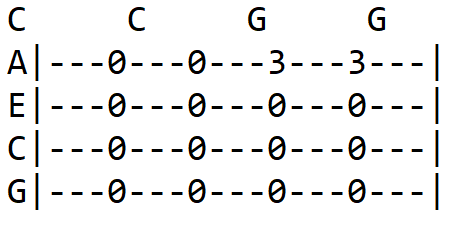
Ukulele tabs are the short form of ukulele tablature. It is a shorthand way to read and write your music for future use.
It’s different and even easier to learn than sheet music which is quite overwhelming for beginners.
Ukulele tabs are quite simple and easy-to-read versions of music theory.
In ukulele tabs, there are numbers and symbols used to represent each string and fret which help you to understand the position of your fingers on the fretboard.
You can think of it as a visual representation of where to place your fingers on your ukulele’s fretboard.
If you learn and understand these numbers and tabs, you can then easily read the music and play it on your ukulele.
The Basics of Ukulele Tabs
So, first, start off with the basics of ukulele tabs.
Each ukulele tab consists of a diagram of the ukulele fretboard which has 4 horizontal lines representing the strings of ukulele. It also has some numbers which represent the frets.
The top line is the string closest to the ground when you hold it in playing position. It is usually the A string of your ukulele.
The bottom line is the upper string which is usually the G string.
The numbers are the indicator of frets on which you place your fingers.
Let’s take an example. If you see the number “1” is on the top line that means you should place your finger on the 1st fret of the A string.
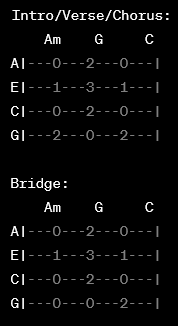
Similarly, if you see the number “5” is on the 2nd line that means you should place your finger on the 5th fret of the E string.
Number “0” on any line represents the open string in which you don’t press any fret.
Advance ukulele tabs also include symbols to represent different playing techniques, such as slides, hammer-ons, and pull-offs.
You will see these symbols written above the related numbers which are a bit confusing for you at first, but with proper knowledge (which you get in this guide) you will start understanding them.
Note: Ukulele tabs do not provide you the information about rhythm or timing. That’s one of the disadvantages of tabs. You have to listen to the song or read sheet music or chord chart to get the knowledge of timing.
Now that you have the basic knowledge of ukulele tabs, it’s time to break down their parts.
First off,
Anatomy of Ukulele Tabs

In this section, we will discuss the anatomy of ukulele tabs.
Ukulele tab consists of a 4 stings fretboard diagram. The horizontal lines represent the strings, and the numbers indicate which fret to play on each string.
The top line is “A” string which is the closest to the ground when you hold your ukulele in playing position.
Similarly, bottom line is “G” string.
Here is an example of a simple ukulele tab for the song “Twinkle, Twinkle, Little Star”.
A|—0—|—0—|—2—|—2—|—4—|—4—|—2—|
E|——-|——-|——-|——-|——-|——-|——-|
C|——-|——-|——-|——-|——-|——-|——-|
G|——-|——-|——-|——-|——-|——-|——-|
In the above example, you will see the numbers indicate the frets to play on a string.
Like, You have to place your finger on the 2nd fret on the A string, The vertical line on the frets represents bars that are used to separate measures of music.
In the above example, each bar has 6 beats.
As I have mentioned above, in ukulele tabs, there are symbols used to represent different techniques, such as slides, hammer-ons, pull-offs etc.
Here are these symbols which are generally written above the corresponding numbers.
- / or \ : Use to slide up or down in the fret
- h : This is hammer-on symbol
- p : pull-off symbol
- ~ : vibrato symbol
- . : staccato symbol
- x : mute the string symbol
- v : strum down
- ^ : strum up
Below I have give the details of all these symbols.
Maybe, the tab author uses some other symbols for the same. In this case, you should read the legend or key provided by the tab author.
Ukulele Tabs Symbols
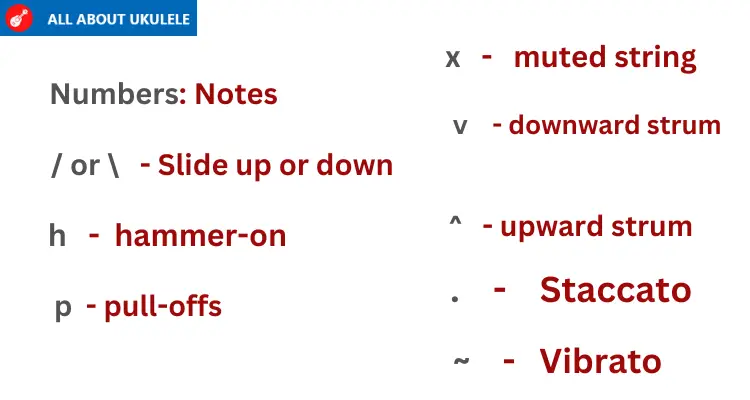
- Numbers: Numbers are used to indicate which fret to place your finger on.
- / or \ : These symbols are used to indicate a slide up or down to the corresponding fret. Like, a “7/9” on the E string indicates you to play a note on the 7th fret and then slide up to the 9th fret without lifting your finger from the string. Similarly “9\7” on A string guide you to play a note on the 9th fret and then slide down to the 7th fret without lifting your finger from the string.
- h : “h” is used for a hammer-on. Hammer on is when you pluck the string and then immediately press down on the corresponding fret without plucking the string again. Let’s take an example: “2h4” on the A string, indicates that you have to pluck the string on the 2nd fret and then hammer onto the 4th fret without plucking the string again.
- p : “p” symbol is used for pull-offs. Pull-off means you pluck the string and then immediately lift your finger from the fret without plucking the string again. Like, if you see the symbol “4p2” on the A string, you have to pluck the string on the 4th fret and then pull-off to the 2nd fret without picking the string again.
- ~ : This symbol is used for vibrato. Like you have to waver the pitch slightly while holding down your finger on fret. For example, the “7~” symbol on the E string asks you to hold down the 7th fret and then wiggle your finger slightly to create a vibrato effect on your ukulele.
- . : A dot symbol is used to indicate staccato. Staccato means you have to play the note short and detached. “5.” on the A string indicates you to pluck the string on the 5th fret and then immediately stop and mute the string with a slight touch of your finger.
- x : “x” is used for a muted string.
- v : “v” symbol is used for downward strum. Like “vvvv” above the tab, indicates to strum down 4 times.
- ^ : This symbol used for upward strum. Like “^^^^” above the tab indicates strum up 4 times.
How to Interpret and Play Chords in Ukulele Tabs
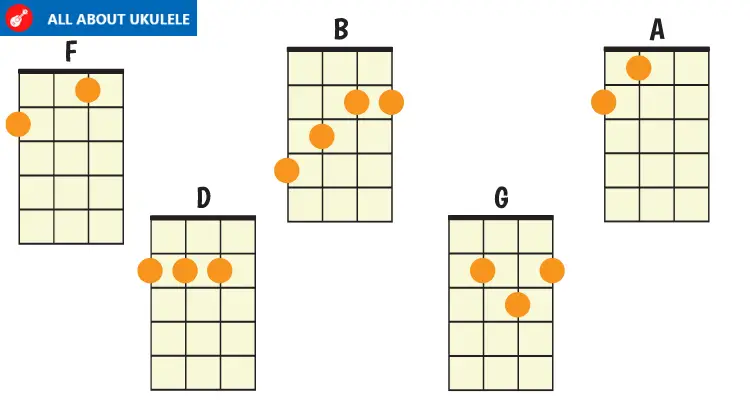
Interpreting chords in ukulele tabs is a skill that develops with time and practice.
As you know chords are a group of notes that you play together to create harmony and rhythm in the song.
In ukulele tabs, you will find them as a letter or a combination of letters.
In this section, I will show you how you can easily interpret and play chords with the help of ukulele tabs.
- Identifying the chord: This first and most crucial step to interpreting chords in the tab. You can see the chord written in a letter or combination of letters. Like, “C” indicates the C chord, “Am” indicates the Am chord, and “G7” indicates the G7 minor chord.
- Know the fingers used: After identifying the chord you have to know the finger positions. Like which strings and frets you need to press down to form the chord. The best way is to memorize chord diagrams or charts.
- Reading the tab: Now you know the chord name and finger positions, you should know how many beats to hold the chord. It is best understood according to the time signature. For example, if the time signature is 4/4, you have to hold each chord for 4 beats.
- Switch in between chords: In most f the songs 3 to 4 chords are used. So, you have to switch between the chords throughout the song. The transition from 1 chord to another is shown in the tab with a slash “/” or a hyphen “-“. Let’s take an example. If the tab indicates “C – G7,” you have to play the C chord for one bar and then shift to the G7 chord for the next bar.
- Now is the time to practice: Practice makes you perfect. So, once you identified the chords, it’s time to practice the chord chart. With practice, you will become perfect at interpreting play the chords in ukulele tabs.
How to Play Ukulele Tab Melodies

When you know the ukulele numbers, symbols etc, playing melody with the help of ukulele tabs is fun for you.
So, here are the steps, that can help you to play melodies using ukulele tabs.
- You should first understand the melody: First off, you should listen to the melody to find out the rhythm, tempo and melody of the song. It will give you a basic understanding of finger placement.
- Now find the right tab sheet: Now you should find the right tab for the song. You can buy a songbook with tabs or go online to find free tabs.
- Read the tab: Now the most important step is to read the tab. You should read this carefully and interpret the numbers, strings and symbols that I have already described above.
- Try to play the melody by reading the tab: break down the tab in parts and try to play the melody in parts. Then you can join the parts to form the full song. With time you will be perfect in reading melody tabs for ukulele.
Ukulele Tabs Reading Tips and Tricks
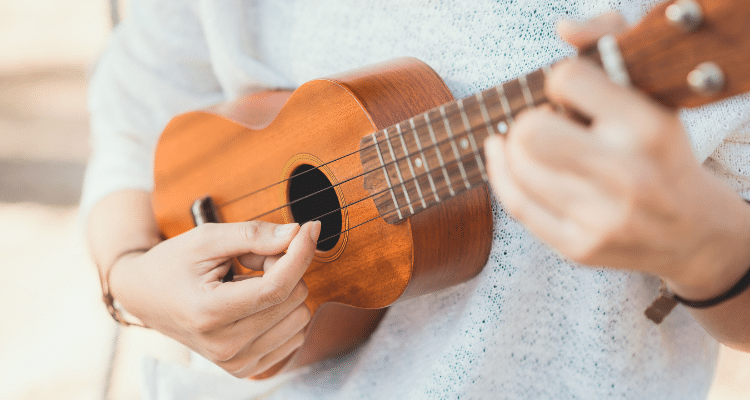
Here I have shared some tips and tricks that will help you to learn ukulele tab reading fast.
- Memorize the symbols: Take your time to understand and memorize the numbers, symbols etc. If you have the symbol in your head you will read the tabs fast.
- Learn chords: You should first learn the basic chords. It will help you to read the tabs in an easy way.
- Break down the tabs: As I have mentioned above, if you break down the tab into smaller sections to practice each section separately, it will help you learn song faster and easier.
- Use a metronome: A metronome helps you to keep your tempo accurate while playing. So, always use a metronome while playing.
- Listen to the song carefully: Listen to the song like a player, not a listener.
Common Mistakes You Should Avoid When Reading Ukulele Tabs
While we read ukulele tabs we could do some mistakes which eventually make it difficult to understand the tab.
Here are some common mistakes you should avoid while reading ukulele tabs.
- Not memorizing the symbols: This is the most common mistake ukulele players do. You should first memorize the symbols like alphabet, otherwise, you will get stuck in between.
- Ignoring the rhythm and tempo: Generally, beginners only focus on the tabs, not the rhythm and tempo. You should not ignore this as a good catch of tempo is and advantage while you are performing.
- They skip the basics: Don’t get excited and jump right to the advanced tab practices. This is one of the common mistakes beginners do. They get overexcited and jump directly to the advances which weakens your basics and you will not be a good tab reader.
- Beginners try to play too fast: Another common mistake is beginners trying to play too fast. Playing fast is not part of perfection. But playing right is that. So, start slowly and gradually increase your speed.
- Beginners do not to the song: Without listening to the song, beginners start practicing which is totally wrong. You should listen to the song carefully and then go to tabs.
How to Use Online Ukulele Tabs Resources
There are tons of websites, Youtube channels and online songbooks where you can find your favorite song’s ukulele tabs.
But finding the right one is quite difficult. Some are not in the original key, some are written by inexperienced players. etc.
So, you should choose only the reputable website that is well-known in the ukulele community and has good reviews.
If you are a beginner, you should choose easy songs and after mastering those songs you should shift to complex songs.
Always keep your ukulele in tune, otherwise, you will not be able to play the tab correctly and blame the online resource for writing wrong tab.
You can read other users’ comments and reviews about the website to get a basic knowledge of their reputation.
Youtube videos are one of the best way to practice ukulele tabs. There are tons of Youtube videos available that you can use to learn ukulele tabs.
Ukulele Tabs Practice Exercises
Here I am sharing 7 daily practices that can help you to master ukulele tabs.
- Practice playing scales: It will improve your finger dexterity.
- Also practice chord progressions: You should practice the basic chords and chord progressions. This can help you with sudden chord changes and improve your muscle memory.
- Play with metronome: A metronome is the best accessory to improve your timing. You should always use it in your practice.
- Memorize the tabs
- Practice fingerpicking patterns: You should choose fingerpicking pattern and practice regularly to develop muscle memory.
- Practice strumming patterns: Also practice strumming patterns along with fingerpicking. It can be used to play chords smoothly.
- Practice with recorded songs: Practicing with recorded version of songs help you develop your ear and improve your ability to play with other musicians. It also help you to learn the tabs in easy way.
Bottomline
Learning ukulele tabs is a great skill for a ukulele player. Whether you’re a beginner or an experienced musician it will help you to read the notes easily.
After understanding the basics of ukulele tabs and the symbols used in them, you can easily interpret chords and melodies.
You can expand your knowledge of songs and improve your playing skills on ukulele.
But you should avoid common mistakes while learning ukulele tabs. There are tons of online resources available to scale up your ukulele tab learning that you can use to become a good ukulele tab reader.
That’s it.
Related,
